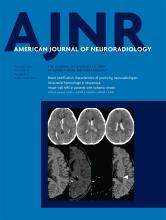Index by author
Igwe, K.C.
- Adult BrainOpen AccessIncreased Diameters of the Internal Cerebral Veins and the Basal Veins of Rosenthal Are Associated with White Matter Hyperintensity VolumeA.L. Houck, J. Gutierrez, F. Gao, K.C. Igwe, J.M. Colon, S.E. Black and A.M. BrickmanAmerican Journal of Neuroradiology October 2019, 40 (10) 1712-1718; DOI: https://doi.org/10.3174/ajnr.A6213
Irie, R.
- Adult BrainOpen AccessWhite Matter Abnormalities in Multiple Sclerosis Evaluated by Quantitative Synthetic MRI, Diffusion Tensor Imaging, and Neurite Orientation Dispersion and Density ImagingA. Hagiwara, K. Kamagata, K. Shimoji, K. Yokoyama, C. Andica, M. Hori, S. Fujita, T. Maekawa, R. Irie, T. Akashi, A. Wada, M. Suzuki, O. Abe, N. Hattori and S. AokiAmerican Journal of Neuroradiology October 2019, 40 (10) 1642-1648; DOI: https://doi.org/10.3174/ajnr.A6209
Ishak, G.E.
- LetterOpen AccessChimeric Antigen Receptor T-Cell Neurotoxicity Neuroimaging: More Than Meets the EyeJ. Gust and G.E. IshakAmerican Journal of Neuroradiology October 2019, 40 (10) E50-E51; DOI: https://doi.org/10.3174/ajnr.A6184
Iv, M.
- FELLOWS' JOURNAL CLUBAdult BrainYou have accessPerfusion MRI-Based Fractional Tumor Burden Differentiates between Tumor and Treatment Effect in Recurrent Glioblastomas and Informs Clinical Decision-MakingM. Iv, X. Liu, J. Lavezo, A.J. Gentles, R. Ghanem, S. Lummus, D.E. Born, S.G. Soltys, S. Nagpal, R. Thomas, L. Recht and N. FischbeinAmerican Journal of Neuroradiology October 2019, 40 (10) 1649-1657; DOI: https://doi.org/10.3174/ajnr.A6211
Forty-seven patients with high-grade gliomas (primarily glioblastoma) with recurrent contrast-enhancing lesions on DSC-MR imaging were retrospectively evaluated after surgical sampling. Histopathologic examination defined treatment effect versus tumor. Normalized relative CBV thresholds of 1.0 and 1.75 were used to define low, intermediate, and high fractional tumor burden classes in each histopathologically defined group. Performance was assessed with an area under the receiver operating characteristic curve. Mean low fractional tumor burden, high fractional tumor burden, and relative CBV of the contrast-enhancing volume were significantly different between treatment effect and tumor with tumor having significantly higher fractional tumor burden and relative CBV and lower fractional tumor burden. High fractional tumor burden and low fractional tumor burden define fractions of the contrast-enhancing lesion volume with high and low blood volume, respectively, and can differentiate treatment effect from tumor in recurrent glioblastomas. Fractional tumor burden maps can also help to inform clinical decision-making.
Izbudak, I.
- LetterYou have accessReply:E. Bulut, J. Karakaya, S. Salama, M. Levy, T.A.G.M. Huisman and I. IzbudakAmerican Journal of Neuroradiology October 2019, 40 (10) E62; DOI: https://doi.org/10.3174/ajnr.A6216








